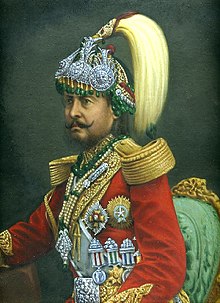
Back جونغ بهادر رنا Arabic জঙ্গবাহাদুর রাণা Bengali/Bangla Džang Bahádur Czech Jang Bahadur Rana German जङ्गबहादुर राणा DTY Jung Bahadur Rana Spanish Jang Bahadur Finnish Jung Bahadur Rana French जङ्गबहादुर राणा Hindi Jang Bahadur Rana ID
Jung Bahadur Rana | |
|---|---|
 Jung Bahadur Rana in 1887 | |
| 8th Prime Minister of Nepal | |
| Maharaja of Kaski and Lamjung | |
| In office 15 September 1846 – 1 August 1856 | |
| Monarchs | King Rajendra King Surendra |
| Preceded by | Fateh Jung Shah |
| Succeeded by | Bam Bahadur Kunwar |
| In office 28 June 1857 – 25 February 1877 | |
| Monarch | King Surendra |
| Preceded by | Bam Bahadur Kunwar |
| Succeeded by | Ranodip Singh Kunwar |
| Personal details | |
| Born | 18 June 1817 Balkot, Arghakhanchi district, Kingdom of Nepal |
| Died | 25 February 1877 (aged 59) Patharghat, Rautahat, Kingdom of Nepal |
| Spouse(s) | Nanda Kumari (second wife); Hiranya Garbha Devi (ninth wife) |
| Children | Jagat Jung Rana, Lalit Rajeshwori Rajya Lakshmi Devi, Somgarva Divyeshwari Rajya Laxmi, Padma Jung Bahadur Rana, Badan Kumari, Jit Jung Rana |
| Relatives | See Kunwar family; see Thapa dynasty; see Rana dynasty |
Jung Bahadur Rana, GCB, GCSI, was born Bir Narsingh Kunwar (1817-1877). His mother, Ganesh Kumari, was the daughter of Kaji Nain Singh Thapa, the brother of Mukhtiyar Bhimsen Thapa from the prominent Thapa dynasty.[1] During his lifetime, Jung Bahadur eliminated factional fighting at court, removed his family's rivals such as the Pandes and Basnyats, introduced innovations in the bureaucracy and judiciary, and made efforts to modernize Nepal.[2] He is considered a significant figure in Nepalese history. Some modern historians blame Jung Bahadur for initiating a dark period in Nepalese history marked by an oppressive dictatorship that lasted 104 years, while others attribute this period to his nephews, the Shumsher Ranas.[3] Rana's rule is often associated with tyranny, debauchery, economic exploitation, and religious persecution.[4][5]
In 1846, Rana was accused of conspiring with the junior queen to become prime minister by placing the queen's son on the throne.[6] His original name was Bir Narsingh Kunwar, but he was commonly known as Jung Bahadur, a name given to him by his maternal uncle, Mathabar Singh Thapa.[7] [3]
- ^ JBR, PurushottamShamsher (1990). Shree Teen Haruko Tathya Britanta (in Nepali). Bhotahity, Kathmandu: Vidarthi Pustak Bhandar. ISBN 99933-39-91-1.
- ^ Manjushree Thapa (2013). Forget Kathmandu. New Delhi: Aleph Book Company. p. 302. ISBN 978-9382277002.
- ^ a b Rana, Purushottam S.J.B. (1998). Jung Bahadur Rana: the story of his rise and glory. Book Faith India. p. 150. ISBN 81-7303-087-1.
- ^ Dietrich, Angela (1996). "Buddhist Monks and Rana Rulers: A History of Persecution". Buddhist Himalaya: A Journal of Nagarjuna Institute of Exact Methods. Archived from the original on 1 October 2013. Retrieved 17 September 2013.
- ^ Lal, C. K. (16 February 2001). "The Rana resonance". Nepali Times. Archived from the original on 28 September 2013. Retrieved 17 September 2013.
- ^ Neupane, Poonam (5 November 2019). "Best Explanation Biography & Facts About Jung Bahadur Rana You Have Ever Read". ImNepal. Archived from the original on 8 August 2020. Retrieved 19 November 2019.
- ^ Gartoula, Gopal. "Jung Bahadur's destitute descendants". Archived from the original on 4 January 2022. Retrieved 4 January 2022.
© MMXXIII Rich X Search. We shall prevail. All rights reserved. Rich X Search